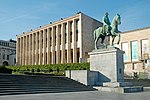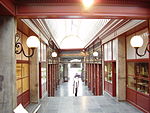June 2017 Brussels attack
2017 crimes in Belgium2017 in Brussels2017 in rail transportBuilding bombings in EuropeCity of Brussels ... and 6 more
Failed terrorist attempts in EuropeImprovised explosive device bombings in BelgiumJune 2017 crimes in EuropeRail transport in BelgiumTerrorist incidents in Belgium in 2017Terrorist incidents in Brussels

On 20 June 2017, a terrorist bomb caused a small explosion at Brussels Central Station in Brussels, Belgium; there were no casualties. Soldiers patrolling the station subsequently killed the suspect with three to four shots, according to eyewitnesses. The perpetrator was Oussama Zariouh, a 36-year-old Moroccan national who lived in the Molenbeek district of Brussels and who had assembled a defective explosive device.
Excerpt from the Wikipedia article June 2017 Brussels attack (License: CC BY-SA 3.0, Authors, Images).June 2017 Brussels attack
Cantersteen - Kantersteen, City of Brussels Pentagon (Brussels)
Geographical coordinates (GPS) Address Nearby Places Show on map
Geographical coordinates (GPS)
| Latitude | Longitude |
|---|---|
| N 50.8454 ° | E 4.3568 ° |
Address
Bruxelles-Central - Brussel-Centraal
Cantersteen - Kantersteen
1000 City of Brussels, Pentagon (Brussels)
Belgium
Open on Google Maps











